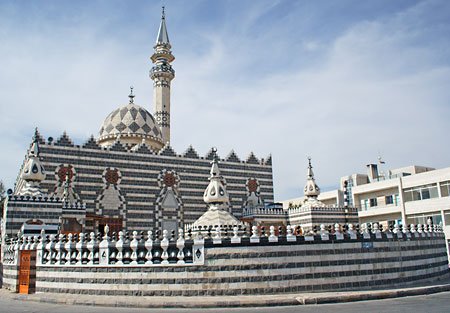Islam religion
Islam, major world religion promulgated by the Prophet Muhammad in Arabia in the 7th century ce. The Arabic term islām, literally “surrender,” illuminates the fundamental religious idea of Islam—that the believer (called a Muslim, from the active particle of islām) accepts surrender to the will of Allah (in Arabic, Allāh: God). Allah is viewed as the sole God—creator, sustainer, and restorer of the world. The will of Allah, to which human beings must submit, is made known through the sacred scriptures, the Qurʾān (often spelled Koran in English), which Allah revealed to his messenger, Muhammad. In Islam Muhammad is considered the last of a series of prophets (including Adam, Noah, Abraham, Moses, Solomon, and Jesus), and his message simultaneously consummates and completes the “revelations” attributed to earlier prophets.

Retaining its emphasis on an uncompromising monotheism and a strict adherence to certain essential religious practices, the religion taught by Muhammad to a small group of followers spread rapidly through the Middle East to Africa, Europe, the Indian subcontinent, the Malay Peninsula, and China. By the early 21st century there were more than 1.5 billion Muslims worldwide. Although many sectarian movements have arisen within Islam, all Muslims are bound by a common faith and a sense of belonging to a single community.
This article deals with the fundamental beliefs and practices of Islam and with the connection of religion and society in the Islamic world. The history of the various peoples who embraced Islam is covered in the article Islamic world.
The legacy of Muhammad
From the very beginning of Islam, Muhammad had inculcated a sense of brotherhood and a bond of faith among his followers, both of which helped to develop among them a feeling of close relationship that was accentuated by their experiences of persecution as a nascent community in Mecca. The strong attachment to the tenets of the Qurʾānic revelation and the conspicuous socioeconomic content of Islamic religious practices cemented this bond of faith. In 622 ce, when the Prophet migrated to Medina, his preaching was soon accepted, and the community-state of Islam emerged. During this early period, Islam acquired its characteristic ethos as a religion uniting in itself both the spiritual and temporal aspects of life and seeking to regulate not only the individual’s relationship to God (through conscience) but human relationships in a social setting as well. Thus, there is not only an Islamic religious institution but also an Islamic law, state, and other institutions governing society. Not until the 20th century were the religious (private) and the secular (public) distinguished by some Muslim thinkers and separated formally in certain places such as Turkey.
This dual religious and social character of Islam, expressing itself in one way as a religious community commissioned by God to bring its own value system to the world through the jihād (“exertion,” commonly translated as “holy war” or “holy struggle”), explains the astonishing success of the early generations of Muslims. Within a century after the Prophet’s death in 632 ce, they had brought a large part of the globe—from Spain across Central Asia to India—under a new Arab Muslim empire.
The period of Islamic conquests and empire building marks the first phase of the expansion of Islam as a religion. Islam’s essential egalitarianism within the community of the faithful and its official discrimination against the followers of other religions won rapid converts. Jews and Christians were assigned a special status as communities possessing scriptures and were called the “people of the Book” (ahl al-kitāb) and, therefore, were allowed religious autonomy. They were, however, required to pay a per capita tax called jizyah, as opposed to pagans, who were required to either accept Islam or die. The same status of the “people of the Book” was later extended in particular times and places to Zoroastrians and Hindus, but many “people of the Book” joined Islam in order to escape the disability of the jizyah. A much more massive expansion of Islam after the 12th century was inaugurated by the Sufis (Muslim mystics), who were mainly responsible for the spread of Islam in India, Central Asia, Turkey, and sub-Saharan Africa (see below).
Beside the jihad and Sufi missionary activity, another factor in the spread of Islam was the far-ranging influence of Muslim traders, who not only introduced Islam quite early to the Indian east coast and South India but also proved to be the main catalytic agents (beside the Sufis) in converting people to Islam in Indonesia, Malaya, and China. Islam was introduced to Indonesia in the 14th century, hardly having time to consolidate itself there politically before the region came under Dutch hegemony.
Sources of Islamic doctrinal and social views
Islamic doctrine, law, and thinking in general are based upon four sources, or fundamental principles (uṣūl): (1) the Qurʾān, (2) the Sunnah (“Traditions”), (3) ijmāʿ (“consensus”), and (4) ijtihād (“individual thought”).
The Qurʾān (literally, “reading” or “recitation”) is regarded as the verbatim word, or speech, of God delivered to Muhammad by the archangel Gabriel. Divided into 114 suras (chapters) of unequal length, it is the fundamental source of Islamic teaching. The suras revealed at Mecca during the earliest part of Muhammad’s career are concerned mostly with ethical and spiritual teachings and the Day of Judgment. The suras revealed at Medina at a later period in the career of the Prophet are concerned for the most part with social legislation and the politico-moral principles for constituting and ordering the community.

Sunnah (“a well-trodden path”) was used by pre-Islamic Arabs to denote their tribal or common law. In Islam it came to mean the example of the Prophet—i.e., his words and deeds as recorded in compilations known as Hadith (in Arabic, Ḥadīth: literally, “report”; a collection of sayings attributed to the Prophet). Hadith provide the written documentation of the Prophet’s words and deeds. Six of these collections, compiled in the 3rd century ah (9th century ce), came to be regarded as especially authoritative by the largest group in Islam, the Sunnis. Another large group, the Shīʿites, has its own Hadith contained in four canonical collections.
The doctrine of ijmāʿ, or consensus, was introduced in the 2nd century ah (8th century ce) in order to standardize legal theory and practice and to overcome individual and regional differences of opinion. Though conceived as a “consensus of scholars,” ijmāʿ was in actual practice a more fundamental operative factor. From the 3rd century ah ijmāʿ has amounted to a principle of stability in thinking; points on which consensus was reached in practice were considered closed and further substantial questioning of them prohibited. Accepted interpretations of the Qurʾān and the actual content of the Sunnah (i.e., Hadith and theology) all rest finally on the ijmāʿ in the sense of the acceptance of the authority of their community.
Ijtihād, meaning “to endeavour” or “to exert effort,” was required to find the legal or doctrinal solution to a new problem. In the early period of Islam, because ijtihād took the form of individual opinion (raʾy), there was a wealth of conflicting and chaotic opinions. In the 2nd century ah ijtihād was replaced by qiyās (reasoning by strict analogy), a formal procedure of deduction based on the texts of the Qurʾān and the Hadith. The transformation of ijmāʿ into a conservative mechanism and the acceptance of a definitive body of Hadith virtually closed the “gate of ijtihād” in Sunni Islam while ijtihād continued in Shiʿism. Nevertheless, certain outstanding Muslim thinkers (e.g., al-Ghazālī in the 11th–12th century) continued to claim the right of new ijtihād for themselves, and reformers in the 18th–20th centuries, because of modern influences, caused this principle once more to receive wider acceptance.
The Qurʾān and Hadith are discussed below. The significance of ijmāʿ and ijtihād are discussed below in the contexts of Islamic theology, philosophy, and law.
Doctrines of the Qurʾān
God
The doctrine about God in the Qurʾān is rigorously monotheistic: God is one and unique; he has no partner and no equal. Trinitarianism, the Christian belief that God is three persons in one substance, is vigorously repudiated. Muslims believe that there are no intermediaries between God and the creation that he brought into being by his sheer command, “Be.” Although his presence is believed to be everywhere, he is not incarnated in anything. He is the sole creator and sustainer of the universe, wherein every creature bears witness to his unity and lordship. But he is also just and merciful: his justice ensures order in his creation, in which nothing is believed to be out of place, and his mercy is unbounded and encompasses everything. His creating and ordering the universe is viewed as the act of prime mercy for which all things sing his glories. The God of the Qurʾān, described as majestic and sovereign, is also a personal God; he is viewed as being nearer to one than one’s own jugular vein, and, whenever a person in need or distress calls him, he responds. Above all, he is the God of guidance and shows everything, particularly humanity, the right way, “the straight path.”
This picture of God—wherein the attributes of power, justice, and mercy interpenetrate—is related to the concept of God shared by Judaism and Christianity and also differs radically from the concepts of pagan Arabia, to which it provided an effective answer. The pagan Arabs believed in a blind and inexorable fate over which humans had no control. For this powerful but insensible fate the Qurʾān substituted a powerful but provident and merciful God. The Qurʾān carried through its uncompromising monotheism by rejecting all forms of idolatry and eliminating all gods and divinities that the Arabs worshipped in their sanctuaries (ḥarams), the most prominent of which was the Kaʿbah sanctuary in Mecca itself.